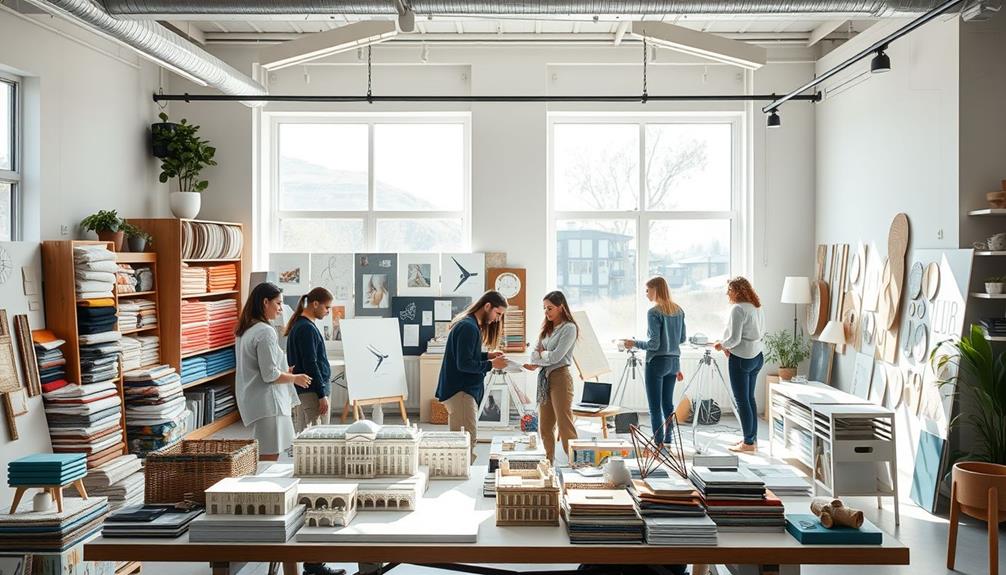To get a Bachelor's Degree in Interior Design, start by researching accredited programs that fit your interests. Check for schools recognized by the Council for Interior Design Accreditation (CIDA) and verify they offer courses covering color theory, space planning, and sustainable design. Prepare a portfolio showcasing your skills and creativity, as most programs require this for admission. Don't forget to explore financial aid options like scholarships and FAFSA. Finally, think about your career path—roles like Commercial Designer or Space Planner could be ahead. You'll discover more about this exciting field as you explore further. Once enrolled in a program, take advantage of opportunities to gain practical experience through internships and volunteer work. Network with industry professionals and join professional organizations to stay up-to-date with the latest trends and techniques. As you build your skills and expertise, consider seeking out interior design business tips from mentors and successful entrepreneurs in the field to help guide your career path.
Key Takeaways
- Research accredited programs in interior design, ensuring they are recognized by the Council for Interior Design Accreditation (CIDA).
- Prepare a portfolio showcasing your design skills, including 10-15 high-quality pieces.
- Meet admission requirements, which typically include a high school diploma, letters of recommendation, and a personal statement.
- Consider financial aspects, including tuition costs and available scholarships, and complete FAFSA for aid eligibility.
- Explore career opportunities post-graduation, such as commercial and residential interior design roles, and consider obtaining certification.
Research Accredited Programs

When researching accredited programs for a Bachelor's degree in Interior Design, you'll often find that quality varies considerably between institutions. Start by checking for institutional accreditation from organizations like the Council for Interior Design Accreditation (CIDA). This guarantees the educational curriculum and faculty expertise meet industry standards, which is essential for future Interior Designers.
Look for programs offering a Bachelor of Science or Bachelor of Arts in Interior Design. Focus on institutions that cover key topics such as color theory, space planning, and sustainable design practices.
Additionally, verify that the interior design program includes hands-on studio courses and internship opportunities. These experiences are critical for gaining practical skills and building a professional portfolio.
Also, investigate the availability of elective courses that allow you to tailor your education to specific interests, whether that's residential or commercial design. This flexibility can enhance your learning experience and better prepare you for your career.
Admission Requirements

Typically, admission to a bachelor's degree program in interior design requires a high school diploma or equivalent. To guarantee you meet the admission requirements, here are four key elements you'll need:
- Portfolio: Most programs require you to submit a portfolio that showcases your design work. This is vital for demonstrating your creative skills and potential.
- Standardized Test Scores: Some institutions may consider standardized test scores, such as the SAT or ACT, during the admission process. Check specific program requirements to see if this applies.
- Letters of Recommendation: You'll often need to provide letters of recommendation from educators or professionals in the field. These letters should reflect your abilities and passion for interior design.
- Personal Statement: A personal statement outlining your interest in interior design is usually necessary. This document allows you to express your motivation and goals within the field.
Portfolio Development

Creating a compelling portfolio is a vital step in your journey toward earning a bachelor's degree in interior design. Start assembling your portfolio early by including a diverse range of work, such as drawings, sketches, and completed design projects. Aim for at least 10-15 high-quality pieces that demonstrate your skills in areas like color theory, space planning, and material selection.
To help you organize your portfolio effectively, consider the following structure:
| Type of Work | Description | Purpose |
|---|---|---|
| Academic Projects | School assignments and projects | Showcase knowledge and skills |
| Personal Work | Independent designs and concepts | Reflect your unique style |
| Internships/Volunteer | Experience in real-world settings | Highlight practical understanding |
Tailor your portfolio presentation to meet the specific requirements of the interior design programs you're applying to. Each piece should reflect your design philosophy and artistic abilities. Additionally, consider creating an online portfolio for easier sharing with admissions committees and potential employers. This approach not only enhances your portfolio development but also positions you as a forward-thinking Interior Designer in today's digital age.
Financial Considerations

Pursuing a bachelor's degree in interior design involves careful financial planning to guarantee you can manage tuition and related expenses. Tuition costs can vary considerably, ranging from $5,000 to $50,000 annually, depending on the institution and location you choose.
To ease this financial burden, it's crucial to explore all available options.
Here are some financial considerations to keep in mind:
- Research Scholarship Opportunities: Many universities offer merit-based and need-based scholarships specifically for interior design students. Take time to find these options and apply early.
- Complete the FAFSA: Applying for federal and state financial aid through the Free Application for Federal Student Aid can help you qualify for grants, work-study, or low-interest loans, making your education more affordable.
- Budget for Additional Costs: Remember to account for materials, software like AutoCAD and SketchUp, and design supplies, which can add up to several thousand dollars throughout your program.
- Evaluate Return on Investment: Research the average salary for interior designers in your area—around $57,000 annually in Texas—to assess whether your education choices are financially viable.
Career Opportunities

As you complete your bachelor's degree in interior design, you'll find a wealth of career opportunities waiting for you in various settings, from architecture firms to design studios.
You can choose from roles like Commercial Interior Designer, Residential Interior Designer, Space Planner, or Design Showroom Manager. Each position allows you to express your creativity while addressing clients' needs.
In the Greater Houston Area alone, about 1,637 interior designers are employed, showcasing a robust local job market.
With a projected job growth of 2.0% over the next four years, you can expect around 75 annual job openings in this field.
To enhance your prospects, consider obtaining credentials like the Registered Interior Designer (RID) certification, which can set you apart in a competitive job market.
Financially, a career in interior design is viable, with the median wage in Texas at approximately $27.57 per hour, translating to an annual salary of about $57,000.
Conclusion
As you journey through the world of interior design, think of yourself as a gardener nurturing a unique flower. By researching accredited programs, tending to your portfolio, and preparing for the challenges ahead, you'll cultivate a vibrant future. Don't let financial weeds choke your dreams; instead, find creative ways to water your aspirations. With dedication, you'll blossom into a skilled designer, ready to transform spaces and bring beauty to life—one room at a time.






